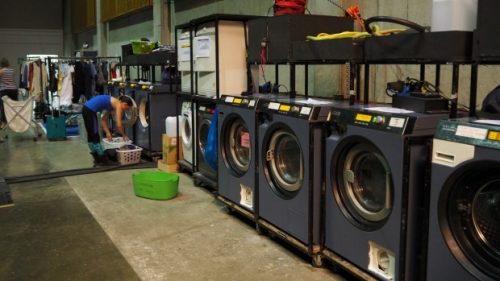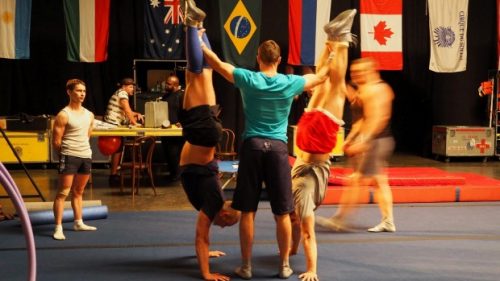With the flags of 24 countries hanging from the ceiling and hurried conversations peppered with fragments of Russian, French, and English, it feels like I could be at the United Nations.
Except there are muscular, shirtless men, tiny women in various states of undress and partially made-up clown faces looking back at me.
Welcome to the world of Cirque du Soleil, where show time for the final tour of the long-running stage show Quidam is getting close.
Lithe young acrobats practise on blue carpet just behind the stage curtains, laughing and chatting while they effortlessly throw and catch each other to the unlikely background noise of industrial-sized washing machines.
After each performance, every item of costume that touches the skin of a performer is washed in the portable laundry lining the backstage wall, touring publicist Jessica Leboeuf explains.
“It’s great for us, because we live in hotels; we have a schedule to wash our own clothes,” she says with a laugh.
But back to the flags. They aren’t there just to look nice.
When Quidam was taken out from under the big top into arena venues, something felt like it was missing backstage, Leboeuf says.
Fluttering around the edge of the big top was the national flag of each cast and crew member on tour.
It was the initiative of Australian technician Simon Fox to replicate it for the arena tours in the same deliberate order.
“The Cirque du Soleil flag is in the middle, then on each side we put the flags according to how many people are represented from that country,” Leboeuf says.
“At the beginning of the arena tour, it’s been kind of a flag battle between Canada, the US, Russia, Ukraine and Brazil.
“Usually, if one new person joins and the flag isn’t moved, the guys hear about it and at the next city it has to be moved; we take it seriously.”
As Leboeuf effortlessly navigates me around the maze of temporary dressing rooms, offices, and meal areas backstage, it’s hard to believe the show rolled into town only a couple of days earlier.
It feels so established and organised – there’s even colour-coded signage.
Unlike the big-top tours that are their own self-sustaining entity, where everything is packed up – even the toilets – the arena tours take an existing venue and try to transform it into the Cirque world.
Conversations backstage vary from issues with immigration to the latest injury niggle or laundry woe.
Although English is supposed to be the official work language, cast and crew adopt words, expressions and mannerisms from each other and many speak with hybrid accents that are impossible to pick out.
“Because we are in the performing arts … we speak with our bodies,” artistic director Marjon Van Grunsven says when asked if miscommunication is ever a problem.
But cross-cultural differences can throw up some challenges, Leboeuf admits.
“With the eastern European cultures, you never say ‘last’ … when they are training, they’ll never say ‘one last time’, because for them it’s fatalistic; it means it’s the last time you’ll ever do that,” she says.
“So when you work with them and you want to get it over with, you say ‘one more’. It’s little things like that you must learn, and sometimes you learn it the hard way.”
In another room, two women sit among racks of colourful clothing delicately repairing costumes in a 2500-piece wardrobe department that, Leboeuf tells me, is worth more than NZ$2 million.
Another is rearranging one of the 300 pairs of hand-painted shoes that help wardrobe alone fill an entire semi-trailer when it goes on the road, along with 20 wigs made from real hair and 30 hats handmade in a workshop in Montreal to fit each performer perfectly.
The cast and crew’s familiarity with one another and obvious comfort with living in close proximity on tour makes me feel like I’m among boarding school kids.
But these aren’t the squabbling younger years, these people have reached the “family” stage of the graduating year and there’s the same mixed emotions as talk turns to their futures when the tour breaks up.
The Australian and New Zealand tours mark Quidam’s last journey before it’s “put to sleep” in Christchurch at the end of February after 20 years, Van Grunsven says.
Some talk of joining another Cirque show, and like many workplaces there’s a noticeboard with jobs up for grabs within the company; others want to pursue stunt work in Hollywood, and for some leaving their touring life behind for a fixed address is appealing.
The show’s longest-serving artist, Mark Ward, has never missed a show in his 22 years with Cirque, and hopes to reach at least 25 years with the company.
He tells me he is turning 50 in December, but he could easily still pass for his starting age of 27.
Even after 17 years playing the same character in Quidam, he’s yet to lose interest.
“My job is to travel around the world and put a smile on people’s faces, and people ask, ‘Are you bored?’, and I think, ‘No!’,” he says.
“Each country you go to you have to reinvent yourself. Sure you do the same things, but they mightn’t get the same jokes … it’s always the same, but it’s different.
“In Japan they love it but they don’t clap out loud … and you think, ‘They hate me’, but at the end of the show they give you flowers and gifts.”
While Cirque’s “intense” casting process weeds out the people who aren’t suited to the lifestyle, Van Grunsven admits some don’t last as long as Ward.
“You do have to sacrifice a lot of daily living … you are always away, you’re always touring,” she says.
“There’s a beautiful aspect to that, you’re in hotels, you go to beautiful countries, you see the world for your job and you get paid for it, but it can be very lonely too because sometimes you see these beautiful places and you want to share them with your loved ones … and you can’t because they are on the other side of the world.”
It’s common for cast and crew to couple up on tour and while Van Grunsven says it’s her job to keep the artists – who range in age from 19 to about 60 – inspired to do their best, she also helps look after their daily lives.
“Sometimes that can be listening to a love story or a children story … they have their things to deal with and I’m basically their sounding board,” she says.
“Every single [Cirque] group is a family, it’s a little community that travels together and once you’re in you can’t get enough of it.
“Even though we’re all eager for a Christmas at home, we still don’t leave because what we experience here is so incredible and extraordinary you don’t want to throw that away.”
It’s no surprise then, to hear that for her the high point of the show is the banquine Italian acrobatic act, where human ability is showcased at its best.
“It’s a big group act where there are no apparatuses involved, no electronics … just human being strength. It’s like a human trampoline and it’s very impressive and beautiful,” she says.
While the artists put their lives at risk every day, Van Grunsven says their skill and intense training mean the chance of injury is slim. They’re are also closely watched by technicians at all times.
“[All the performers] really care about every move they make on stage, they take it very seriously,” she says. “You’ll see them come off stage at the end of their act and there’s the television and right away they’ll watch what they just did.”
{ SOURCE: Stuff.co.nz | http://goo.gl/aFJmFb }

